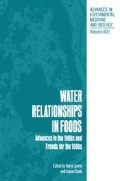Abstract
The use of humectants and drying to make foods safe and stable has been one of the underlying principles of food preservation for centuries. With the more recent discovery that the ratio of water vapor pressure to that of pure water (aw) is a useful parameter when related to microbial growth and other stabilizing factors in foods, a valuable means of predicting stability factors based on water limitation has become available. Microorganisms have been categorized with respect to their capacity to grow and produce metabolites in various conditions of limited aw. In addition, the metabolic basis for microbial inhibition has now been determined and schemes for its genetic control have been uncovered. The implications that these discoveries have in a wide variety of applications are far-reaching.
Access this chapter
Tax calculation will be finalised at checkout
Purchases are for personal use only
Preview
Unable to display preview. Download preview PDF.
References
W.J. Scott, Water relations of Staphylococcus aureus at 30°C, Austral. J. Biol. Sci. 6:549 (1953).
J.H.B. Christian and W.J. Scott, Water relations of Salmonellae at 30°C, Austral. J. Biol. Sci. 6:565 (1953).
J.A. Troller, Water activity and food quality, in: “Water and Food Quality,” T.M. Hardman, ed., Elsevier Appl. Sci., London (1989).
J.Y. McDade and L.B. Hall, Survival of Staphylococcus aureus in the environment. I. Exposure on surfaces, Am. J. Hyg. 78:330 (1963).
L. Leistner, Hurdle technology applied to meat products of the shelf stable product and intermediate moisture types, in: “Properties of Water in Foods,” D. Simatos and J.L. Moulton, eds., Martinus Nijhoff, Dordrecht (1985).
K.A. Larocco and S.E. Martin, Effects of potassium sorbate alone and in combination with sodium chloride on growth of Staphylococcus aureus MF-31, J. Food. Prot. 50:750 (1987).
M. Jakobsen and H.C. Jensen, Combined effects of water activity and pH on the growth of butyric anaerobes in canned pears, Lebensm. Wissensch. Tech. 8:158 (1975).
J.A. Troller, Effects of aw and pH on growth and survival of Staphylococcus aureus, in: “Properties of Water in Foods,” D. Simatos and J.L. Multon, eds., Martinus Nijhoff, Dordrecht (1985).
M.C. Robach and C.L. Stateler, Inhibition of Staphylococcus aureus by potassium sorbate in combination with sodium chloride, tertiary butyl — hydroquinone, butylated hydroxyanisole or ethylene-diamine tetraacetic acid, J. Food Prot. 43:208 (1980).
J.E.L. Corry, The effect of sugars and polyols on the heat resistance of salmonellae, J. Appl. Bact. 37:31 (1974).
W.G. Murrell and W.J. Scott, The heat resistance of bacterial spores at various water activities, J. Gen. Microbiol. 43:411 (1966).
J.A. Troller, Water relations of foodborne bacterial pathogens — An updated review, J. Food Prot. 49:656 (1986).
W.H. Sperber, Influence of water activity on food-borne bacteria — A review, J. Food Prot. 46:142 (1983).
M. Jakobsen, Effect of Aw, on growth and survival of Bacillaceae, in: “Properties of Water in Foods,” D. Simatos and J.L. Multon, eds., Martinus Nijhoff, Dordrecht (1985).
M. Jakobsen and W.G. Murrell, The effect of water activity and aw-controlling solute on sporulation of Bacillus cereus T, J. Appl. Bacteriol. 43:239 (1977).
D.F. Ohye and J.H.B. Christian, Combined effects of temperature, pH and water activity on growth and toxin production by C1. botulinum Types A, B and E, Proc. 5th Int. Symp. on Food Microbiology, Moscow (1966).
A.C. Baird-Parker and B. Freame, Combined effect of water activity, pH, and temperature on the growth of Clostridium botulinum from spore and vegetative cell inocula, J. Appl. Bact. 30:420 (1967).
A.D. Brown and J.R. Simpson, Water relations of sugar-tolerant yeasts: the role of intracellular polyols, J. Gen. Microbiol. 72:589 (1972).
M. Edgeley and A.D. Brown, Response of xerotolerant and nontolerant yeasts to water stress, J. Gen. Microbiol. 104:343 (1978).
W. Epstein, Osmoregulation by potassium transport in Escherlchla coli, FEMS Microbiology Rev. 39:73 (1986).
E.P. Bakker, I.R. Booth, U. Dinnbier, W. Epstein, and A. Gajewska, Evidence for multiple K+ export systems in Escherichla coli, J. Bacteriol. 169:3743 (1987).
J.H.B. Christian and J.A. Waltho, Water relations of Salmonella Oranienburg; Stimulation of respiration by amino acids, J. Gen. Microbiol. 43:345 (1966).
A.D. Brown, Microbial water relations: features of the intracellular composition of sugar-tolerant yeasts, J. Bacteriol. 118:769 (1974).
G.W. Gould and J.C. Measures, Water relations in single cells, Phil. Trans. Royal Soc., Lond. B 278:151 (1977).
L.N. Csonka, A third L-proline permease in Salmonella typhimurium which functions in media of elevated osmatic strength, J. Bacteriol. 151:1433 (1981).
I.R. Booth, J. Cairuy, L. Sutherland, and C.F. Higgins, Enteric bacteria and osmotic stress: an integrated homeostatic system, J. Appl. Bacteriol. Symp. Suppl. 35s (1988).
G.W. Gould, Present state of knowledge of aw effects on microorganisms, in: “Properties of Water in Foods,” D. Simatos and J.L. Moulton, eds., Martinus Nijhoff, Dordrecht (1985).
J.A. Troller and J.V. Stinson, Moisture requirements for growth and metabolite production by lactic acid bacteria, Appl. & Environ. Microbiol. 42:682 (1981).
Author information
Authors and Affiliations
Editor information
Editors and Affiliations
Rights and permissions
Copyright information
© 1991 Springer Science+Business Media New York
About this chapter
Cite this chapter
Troller, J.A. (1991). Trends in Research Related to the Influence of “Water Activity” on Microorganisms in Food. In: Levine, H., Slade, L. (eds) Water Relationships in Foods. Advances in Experimental Medicine and Biology, vol 302. Springer, Boston, MA. https://doi.org/10.1007/978-1-4899-0664-9_17
Download citation
DOI: https://doi.org/10.1007/978-1-4899-0664-9_17
Publisher Name: Springer, Boston, MA
Print ISBN: 978-1-4899-0666-3
Online ISBN: 978-1-4899-0664-9
eBook Packages: Springer Book Archive

